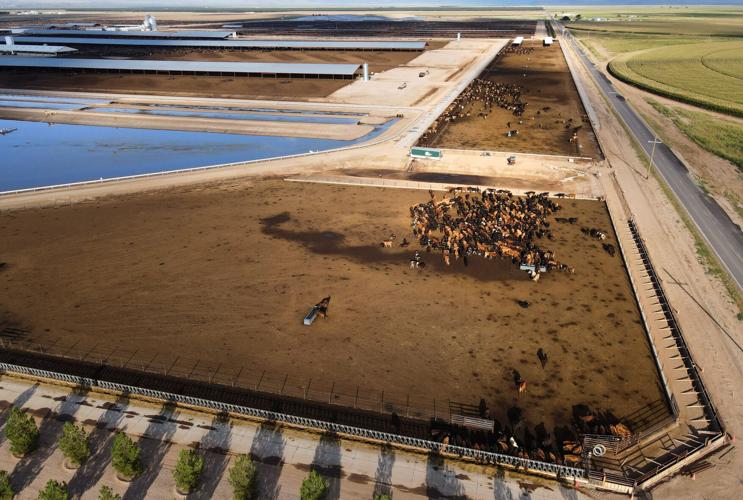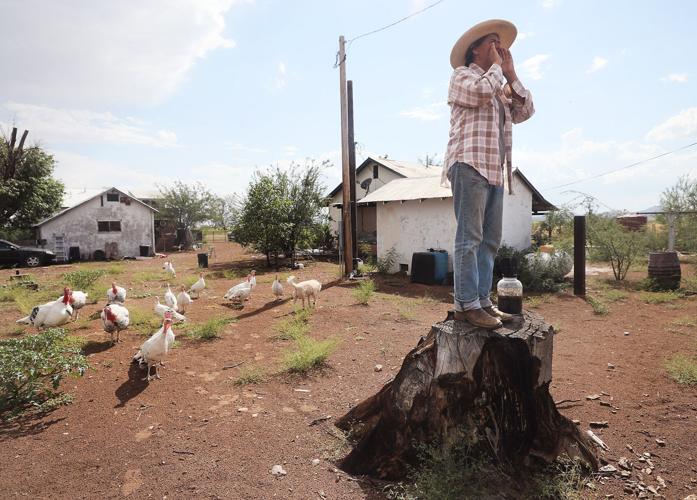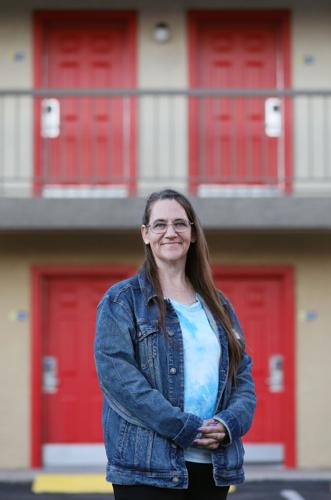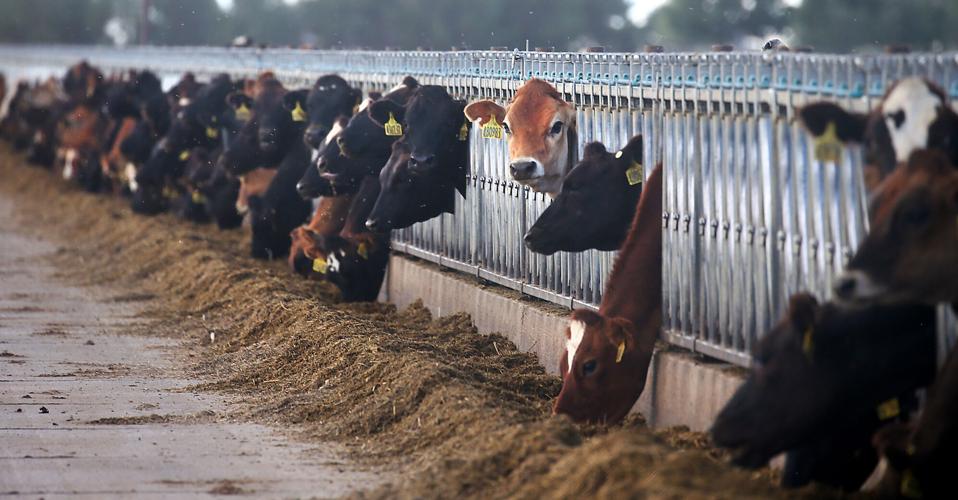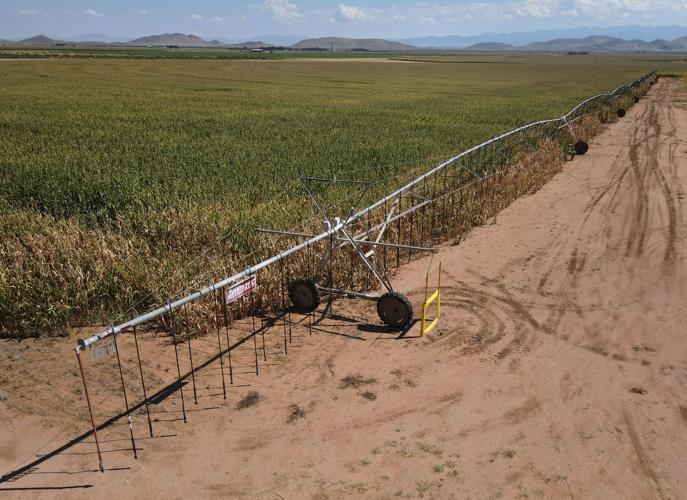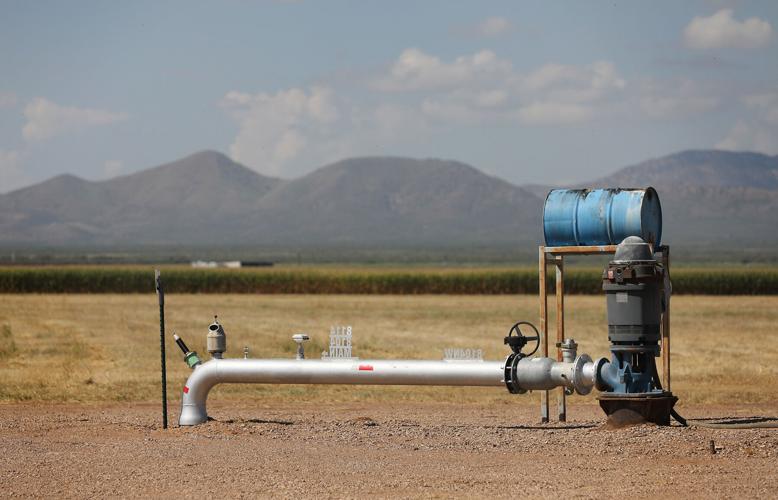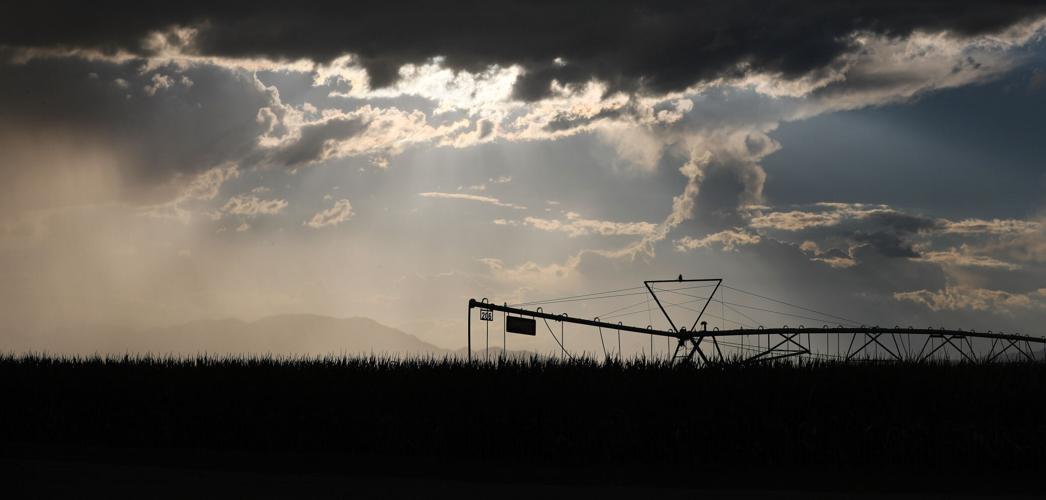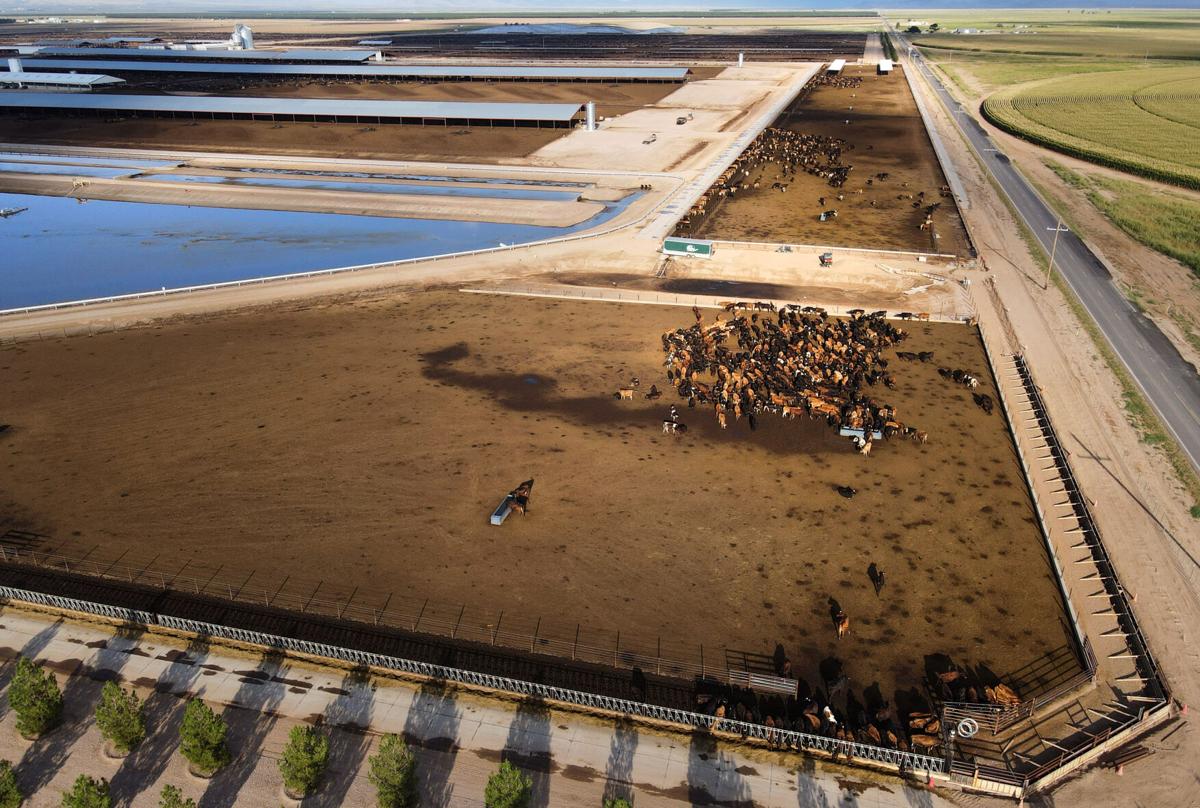In the winter of 2018, Lauralynn Cornelsen moved out of her mobile home in Sunizona, an unincorporated community in southeast Arizona. After more than six years, she was tired of hauling water for drinking and bathing, and she couldn’t afford to drill a well — certainly not one deep enough to survive the impending squeeze once a nearby mega-dairy began to operate.
Cornelsen’s story epitomizes the challenges local residents are facing over the ongoing water crisis in this rural community and others in the Willcox area, a problem that worsens every year and that no person or agency has figured out how to solve. She is one of hundreds of people, mostly low- to middle-income, living in a high-desert landscape whose groundwater levels are rapidly declining as water is pumped to grow alfalfa, corn, nuts, wheat and barley.
The greatest pressure on the region’s aquifer comes from Riverview LLP, a Minnesota-based dairy company whose groundwater pumping is seen by many in the area as the primary cause of their drying wells.
Riverview’s rapid expansion in Arizona, one of the five states it operates in, has environmental and economic consequences. The local industry and resources have been monopolized by a deep-pocketed entity. The groundwater is being depleted, transforming landscapes and lifestyles. Some residents are fed up.
On a winter evening in 2020, Cornelsen stood behind the counter of the Days Inn in Willcox, where she still works as a desk clerk. Inside the quiet lobby — the walls decorated with paintings of cowboys, the continental breakfast bar closed for the night — she spoke resolutely about the previous decade, during which she had tried desperately to make a life for her family in an increasingly parched landscape.
Cornelsen and her six children moved to Sunizona in 2011 from St. David, about 55 miles away. Needing someplace cheap, she said, they bought 2.5 acres for $3,600. “I liked the rural atmosphere, but our main thing was that it was an emergency, and it was inexpensive,” she recalled. “It was what we could afford with our tax refund.”
In Sunizona, population 212, tract, manufactured and mobile homes border dirt roads and the state highway that leads to the Chiricahua Mountains. Sunizona has a mini-mall, a café, an elementary school, a laundromat and a couple of churches, but no post office or even a convenience store.
The Cornelsens first moved two RVs and a van, then a mobile home, onto their land, but the property lacked electricity and had no well. Years later, the family managed to get electricity, but water remained a problem. Almost every day for six years, Cornelsen and her children walked to a church a mile and a half away, where they, and 12 other families, filled 1-gallon jugs with water from a hose.
“It was a real hassle, but you gotta do what you had to do,” Cornelsen said. “I had kids and I had to make sure they were watered.”
At the time, Cornelsen was earning minimum wage as a home-care aide for elderly and disabled patients. She was living paycheck to paycheck, and far from alone: In 2019, according to the census, Sunizona’s annual median household income was $22,500 — barely 61% of the median household income in Willcox, 30 minutes north, and just 38% of the state’s.
She could not afford a new well, as she says well drillers priced one at about $40,000, in part because water levels were so low there. A neighbor had to deepen her well twice in a single year, Cornelsen said.
Water was already scarce and demand was growing: Riverview would soon begin construction on Turkey Creek Dairy, its second dairy in Arizona, just down the road, and it would be drilling deep, she said.

Lauralynn Cornelsen now works at the Days Inn in Willcox. She moved from her mobile home in Sunizona in 2018 because she couldn’t afford a well deep enough for water.
She was also worried about the traffic dust, and other problems she thought a new dairy might bring. Ultimately, it was all too much. In 2018, she gave the property to a close friend from church and moved to Willcox, where she got the job at the Days Inn. Her new property has two wells.
Today, Cornelsen remains angry about what happened. She said Riverview sucking up the water was a major factor driving her and many neighbors away. “Too many people are afraid of saying anything,” she said, her voice taking on a passionate edge. “I believe business runs America, and when the big guy is taking a precious resource like water — that I’m against.”
Nobody knows how many wells have dried up in Sunizona, let alone the entire Willcox Basin, which covers 1,911 square miles in Arizona’s southeast corner, near the New Mexico border. But between 2014 and 2019, records from the Arizona Department of Water Resources (ADWR) show around 20 wells in the Sunizona area were deepened after drying up. In the entire basin during that time, records show that 57 wells were deepened.
While pinning an individual well’s decline on a neighboring well or wells is very difficult, evidence is mounting that the decline of the underground aquifer here has accelerated since Riverview’s arrival. The company has drilled about 80 wells in the Willcox Basin since January 2015, and added six in the Douglas Basin, just south, since it started buying land there in October 2020. Most are at least 1,000 feet deep. Three approach half a mile deep — deeper than any other well in the area. Many lie near Sunizona’s barren wells.
Kevin Wulf, a spokesman for Riverview, acknowledges that the dairy’s water use is a factor in the drying of other wells, but he insists it’s hardly the only one.
“I get it,” Wulf said in leading reporters on a tour of the dairy in early 2020. “We’re the big target.” Wulf, a former elementary school teacher, looked out at the 90-cow milk carousel, which turned slowly like a merry-go-round. “The rumor is: ‘You’re here to suck the valley dry. And then you’re going to leave.’ We don’t want to do that.”
What’s not disputed is that in six years here, Riverview has transformed the Willcox Basin’s appearance and economy. The company bought out nearly 30 local farmers and easily became the basin’s biggest grower. It employs 200 people in Arizona and has built on-site housing for foreign workers among them.
In January 2015, Riverview paid $38 million cash to buy Coronado Dairy, a locally owned operation in the Kansas Settlement area, about 10 miles north of Sunizona, and more than 6,000 acres of surrounding land.
Since then, the company has purchased nearly 51,000 acres in the Willcox and Douglas basins, for more than $180 million, Cochise County land records show. Much of the property was existing farmland the dairy company bought to grow feed for its cows, while some land that had been vacant is now cropland.
Coronado Dairy is now home to 70,000 Jersey-cross heifers, young cows that have not yet lactated. To drive down Kansas Settlement Road is to watch an entire mile of them tick by like a flipbook: honey-brown ears, big doe-eyes, flicking tails. In a barn set back from the road, another 7,000 dairy cows are milked twice daily.
When night falls, high-powered floodlights illuminate the feedlot. It is the only such lighting in a place known for its dark skies and glittering stars, and members of the local astronomy club say that it has affected stargazing. When asked about the increased lighting, though, Wulf said Riverview uses significantly fewer lights here than it does in the Midwest.
In 2019, the company built the Turkey Creek Dairy, a few miles north of Sunizona. Its 17,000 small, white hutches house calves from 2 to 90 days old. At full capacity, it will hold 9,000 dairy cows and 120,000 heifers.
Riverview’s critics say the Minnesota corporation was drawn here by the same freewheeling political climate that brought so many pistachio and pecan farmers to the basin from California and other states. In Arizona, no regulations limit how much water farmers can pump in rural areas outside of five, state-run Active Management Areas.
Most of the management areas cover metro areas for the state's biggest cities including Tuson and Phoenix. They also include fast-growing Pinal County, Santa Cruz County and the Prescott area in Yavapai County.
. The groundwater pumping inside those five years in the state’s midsection is controlled and metered under the Arizona Groundwater Management Act, a pioneering state law passed 40 years ago. But that law bypassed rural areas entirely outside those Active Management Areas -- it doesn’t even require water-use metering in those more remote areas.
“The only reason the water tables are dropping is because more entities are pumping — because there are no rules,” said Kristine Uhlman, a retired University of Arizona hydrologist. “Too many entities have moved in to pump the free water. Take what you want; all you need is the money to drill a well, the deeper the better.”
Wulf, however, said Riverview didn’t come to Arizona because of the lack of water regulations; it was attracted by the dry climate and the large amount of available farmland.
“Because water usage and conservation is important to us, no matter where we’re located, the water use regulation in Willcox was not a determining factor,” he said. “We think about water and talk about water everywhere we’re at.”
Speaking at a February 2020 workshop on groundwater issues, Uhlman used an everyday metaphor — a savings account — to explain the Willcox Basin aquifer’s rapid decline. She spoke at the Sunsites Community Center before about 50 people.
“If your water is old, and it’s not being recharged on a regular basis, that’s a savings account,” Uhlman said, scanning the room. “You’re taking water out of a savings account that’s not being recharged with routine input.”
Surrounded by five mountain ranges, the Willcox Basin’s aquifer amounts to a bountiful savings account. Before large-scale agricultural pumping began around 1940, up to 97 million acre-feet of groundwater was stored there, says a 2018 ADWR report — enough to supply Tucson for about 970 years.
But between 1940 and 2015, extensive pumping by farmers seriously depleted this savings account, removing 6.2 million acre-feet of groundwater and lowering the aquifer by 200 to 300 feet, the ADWR report said.
The sharpest declines were in the Kansas Settlement area, where Riverview’s Coronado Dairy now lies, although they were recorded before Riverview arrived. No comprehensive analysis of water-level declines has been done since 2015. But a former ADWR official said the rate of decline appears to have increased since then, to 3 to 5 feet per year in the entire Willcox Basin, compared to 2 to 4 feet per year from 2010 to 2015. The Sunizona area is also seeing significant declines, said that expert, Frank Corkhill, ADWR’s now-retired chief hydrologist.

Cattle feed at Coronado Dairy, home to 70,000 Jersey-cross heifers, young cows that have not yet lactated. Riverview bought the dairy in 2015 and purchased another 6,000 acres of surrounding land.
In 2015, basin water users pumped about 240,000 acre-feet, about four times more than the aquifer gets in recharge, said Keith Nelson, an ADWR hydrologist who oversaw the department’s 2018 study. Additional wells have since been drilled, so the overdraft could now be bigger, he said.
“Overpumping, or overspending from a savings account, means you don’t give a damn,” Uhlman said. “Or perhaps you have six months to live, and you don’t want anyone to inherit what you worked hard for.”
The overpumping has driven out a few farmers. As Riverview drilled deeper, they feared they’d have to drill deeper — something they couldn’t afford. So they sold out to the dairy.
For 25 years, Glenn Schmidt farmed cotton and alfalfa on 166 acres, a mile south of Coronado Dairy. Four years ago, he and his wife, Linda, sold the land to the dairy colossus for $1.3 million.
“They were drilling deep wells right beside me,” Schmidt, who is 65, said. “At my age, I didn’t see how I could spend $2 million on new wells and try to compete. I had (a well) that was 600 feet. The rest of them were 400- to 500-feet wells. Theirs are 1,200.”
Before Riverview’s arrival, Schmidt’s profits and yields rose for 10 years after he started planting new cotton varieties. “We weren’t ready to quit,” he said. “We’d just got new equipment. When they started drilling those deep wells, it ruined my dream.” He had imagined renting his farm to his two sons and living off the rent money. But, he said, “The boys had to leave, to go find jobs. One of them landed in Kansas, one in Oregon.”
Joe Salvail also felt he had no choice in 2015 but to sell his land after farming alfalfa for 19 years. His well was dropping more than 7 feet a year, and the water level hovered at 480 feet deep. A new well would have cost him $125 per foot. “I knew I was going to have to eventually put in a new well,” he said. “I didn’t have the money to do it.”
Shortly before Salvail sold almost all of his 320 acres to Riverview for just over $1 million, the company drilled a new well just a half-mile north of his land. “They went down 1,300 feet, and they’re pumping 1,800 gallons a minute out of that well now,” he said. “They’re irrigating with (multiple) center pivots pulling water from that well, and I was having trouble to get enough water to irrigate one.”
But Salvail and Schmidt harbor no bitterness. “I’m glad (Riverview) came by,” Salvail said. “It helped me. I have no problems with them. They gave me a decent offer.”
Schmidt said the sale allowed him to leave before things inevitably became worse. “If they wouldn’t have bought my farm, and they kept drilling the wells, I’d have been out of business,” Schmidt said.
In Arizona, even farmers who praise Riverview as a good neighbor and job creator say they’re concerned because the local economy now depends so heavily on it.
John Hart, who farms 10 miles north of the Coronado Dairy, estimates that 70% of the basin’s economy is tied to agriculture, and that Riverview owns one-third of the 60,000 to 70,000 acres farmed in the basin. Riverview is by far the area’s biggest employer.
“It’s kind of like Walmart moving into town,” said Richard Searle, a former county supervisor who grows pistachios on 20 acres, 15 miles from the Coronado Dairy. “If you have 20 farmers and one goes broke, it’s not a huge impact. You have one entity like the dairy, and if they have a problem, it will have a huge economic impact on the valley.”

A center pivot stands in a field owned by Riverview LLP, a Minnesota-based dairy company, along Moore Road in Elfrida. Riverview bought its first piece of land in Elfrida, 4,700 acres, for $20 million in October 2020.
Agricultural water use in the Willcox Basin, after soaring from the 1960s through the 1970s, crashed through the 1980s and ‘90s as farming declined nationally. Starting around 2000, water use started rising again. It hit 172,000 acre-feet by 2014, compared to 110,000 acre feet in the 1990s, U.S. Geological Survey statistics show. From 2015 through 2017, the most recent year statistics are available, agricultural water use rose 18.2%, compared to an 8.7% increase from 2012 to 2015.
Riverview’s arrival could have contributed to the increase in water use. Between January 2015 and the end of 2020, 407 new wells were drilled in the basin; 19.6% were Riverview’s. After inheriting hundreds of existing wells through land purchases, it owns nearly 19% of 799 wells registered in the basin from 2014 through 2019.
Some individual wells in the Kansas Settlement and Sunizona areas have shown some of the worst declines in Arizona, said Frank Corkhill, ADWR’s now-retired chief hydrologist. One Kansas Settlement well dropped 30 feet between 2015 and 2017. Another dropped 45 feet between 2014 and 2017. Two wells each fell 17 feet in 2017 alone — one in Kansas Settlement and one in Sunizona, Corkhill said.
Also, the Arizona Department of Water Resources monitors 49 “index” wells in the Willcox Basin annually. Of these, 37 declined faster from 2015 to 2020 than from 2010 to 2015, while 12 declined at a slower rate or rose during the more recent period.
Thomas Meixner, the University of Arizona’s hydrology and atmospheric sciences department head, reviewed that index well data and said that, in general, “The decline in water levels appears to be accelerating (since 2015). It’s not uniform. Different wells do behave differently. But on average, they are going down at about 6 feet a year now, compared to a little less than 4 feet in 2015.”
Riverview, however, said it uses 25% less water than did farmers who previously farmed the same land, due to more efficient irrigation methods. The company has installed two types of nozzles on each of its 200 irrigation center-pivots. Wulf said they manually switch them out throughout the growing season. “That takes a lot of work,” he said. “It’s labor-intensive.”
Riverview works with a third-party hydrologist to monitor its wells to better understand what is happening in the aquifer, he said.
“We recognize the value of water in Arizona and continually search for new innovations to reduce water usage per acre.”
Even so, the company declines to disclose its actual water use. Wulf calls it “our private business.”
He also said Riverview favors more regulation, including state legislation that would require metering of all rural wells — legislation that so far has gone nowhere.
Some question Riverview’s assertion of a 25% drop in water use. Longtime farmers Salvail and Hart say that while many farmers who sold to Riverview grew one crop per year, Riverview has switched to growing summer and winter crops, boosting water use — a path recently followed by other local farmers.
“They’ll put in a wheat crop and follow it with corn,” Hart said of Riverview.

A well head stands in a field owned by Riverview LLP along West Sheep Trail in Elfrida. The company has drilled about 80 wells in the Willcox Basin since January 2015. Three of them are nearly half a mile deep.
Willcox’s water wars started to heat up in the middle 2010s, as numerous California tree-nut and alfalfa farmers were relocating there. Many homeowners’ wells were drying up. People started complaining at public meetings.
That led to formation of a working group of farmers, ranchers, rural residents and government officials who spent months carefully negotiating a compromise proposal to create a groundwater conservation area for the basin.
Under the plan, finished in late 2015, those who had pumped groundwater within the last five years would be grandfathered. New landowners would face strict limits on future pumping. Most new wells would be reviewed to ensure that they wouldn’t dry up surrounding wells. All well owners would be required to install water meters and report their use to the state.
The proposal ruptured the community and was ignored by the Legislature.
“Today there is not much consensus to do anything,” Hart said. “The guys leading that effort in 2015 got so beat up among their peers, nobody wants to talk about it anymore. If anything is going to happen on the water issue, it has to come from the state.”
Riverview’s Wulf agrees. “We support state regulation,” he said. “We feel like it is more fact-based and less emotional.”
But when former Arizona Gov. and U.S. Interior Secretary Bruce Babbitt spoke at a Sunsites water workshop in March 2020, he urged the Legislature to give county governments authority to develop their own water management plans.
While the state’s 1980 Groundwater Act was a top-down mandate, “most of the things we do in this state, in this country, in communities, start the other way,” said Babbitt, an architect of the 1980 law that regulates water use in urban areas. “We tend to address problems from local governments on upward, to try to find consensus and a path forward. It’s your future, your community, your economy and your neighbors.”
In both 2020 and 2021, Arizona’s Legislature refused to even give committee hearings to bills like Babbitt suggested. The same fate sunk bills that would have required water metering in rural areas.
The water forum at which Babbitt spoke was organized by Peggy Judd, a Cochise County supervisor representing the Willcox Basin. Judd, a longtime supporter of Riverview who lauds its economic benefits, opposed new regulations for years, calling them an intrusion on property rights. She now supports them, as well declines grow more severe.
She has formed a new working group to hammer out a water plan behind closed doors.
Meanwhile, three Sunizona residents who have had to haul water or deepen their wells are trying to form a water district to tax homeowners to pay for a well system for the community. Also, other activists are gathering petition signatures to try to force a November 2022 election to create state-run water management areas to regulate pumping in the Willcox and Douglas Basin to the south.
For now, the Willcox Basin’s water outlook is gloomy at best. According to ADWR’s 2018 groundwater study, based on a computer model, up to 24 million acre-feet of water will be pumped out of the basin by 2115. Water levels could fall by as much as 917 feet in the Kansas Settlement area by 2115 compared to 2115. Even though as much as 78 million acre-feet may remain, much will be so deep that it may not be practical to remove it, ADWR officials have said.
Big farmers like Riverview will be able to get water for a long time because they have the money to keep drilling deeper, Uhlman, the hydrologist, said. Homeowners and smaller farmers won’t be as fortunate.
“These companies have the deep pockets to have longer straws that go down deeper in the aquifer,” she said. “The individual family farmers who originally homesteaded the land — they can only go as deep as their pocketbooks.”

Anastasia Rabin calls out to her horse, Trigger, as her turkeys walk around her home in Elfrida. Rabin says her farm is now almost completely surrounded by Riverview LLP-owned properties. She has lived in Elfrida for nine years and says she has watched industrial farming take over the area.
Thirty miles southwest of Riverview’s Coronado Dairy, Anastasia Rabin stood in the yard next to her small herd of goats and scanned the horizon. She has lived in Elfrida for nearly a decade, and watched as industrial farming appeared in the valley. First it was corn, then the California-owned nut operations — and now Riverview.
In late October 2020, Riverview purchased its first Elfrida property — nearly 4,700 acres for $20 million. Since then, Riverview has amassed a total of over 9,100 Elfrida acres for close to $36 million. Wulf said Riverview plans to farm corn and wheat to feed its cows, but “there are no current plans to build a third dairy in the Elfrida area.”
A few months ago, Rabin started noticing land-use changes in the immediate area. Many neighboring farms have sold to new operations, most recently Riverview, which adjoins her property on two sides. The dairy owns the grain bins towering in the distance and the gravel quarry next door. Across the road, newly assembled irrigation pipes sprawled across one of Riverview’s recently purchased fields. When Rabin looks west across the valley, she can see a flurry of activity: mesquite cleared, wells drilled, pivots installed and fields scraped bare. Loose sand and dirt have been pushed into enormous piles.
Recently, Rabin woke to a dust storm. She stood in her yard and took a phone video of a wall of dust so thick that it blocked the mesquite trees and mountains. “This spring, the dust storms were a full-scale natural disaster,” Rabin said, adding that such storms have become more frequent since the arrival of larger farms and the massive land clearing. She kicked at the ground, covered in several inches of beach-like sand, whorled in patterns by the wind. In some places on her property, as much as 2 feet of sand has accumulated.
“This is desertification in action,” Rabin said — the transformation of a once-biologically diverse landscape into a hotter, drier and much less hospitable environment.
Scenes like that are why residents in the area are pleading with state and local officials to do something — enact groundwater pumping restrictions, or place a moratorium on large livestock operations.
So far, few appear to be listening.

A late-summer rainstorm forms across Cochise County over a center pivot on farmland owned by Riverview LLP. "“We recognize the value of water in Arizona and continually search for new innovations to reduce water usage per acre," says Kevin Wulf, a company spokesman.
Recent monsoon rainfall has revived a natural spring on a residential street near Starr Pass.


